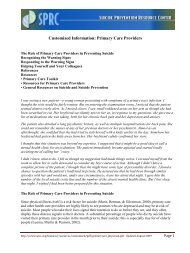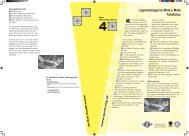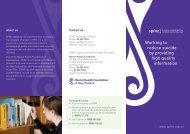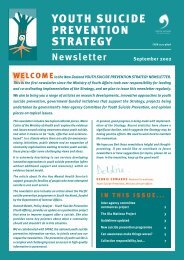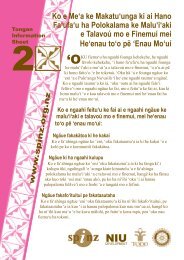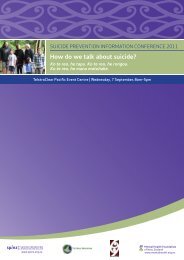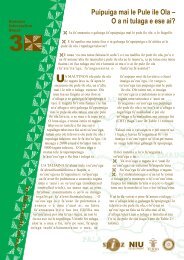A background document to support Kia Piki Te Ora O Te ... - SPINZ
A background document to support Kia Piki Te Ora O Te ... - SPINZ
A background document to support Kia Piki Te Ora O Te ... - SPINZ
Create successful ePaper yourself
Turn your PDF publications into a flip-book with our unique Google optimized e-Paper software.
Table One: Suicide risk fac<strong>to</strong>rs for New Zealand youth generally,<br />
Māori youth and indigenous youth internationally<br />
NEW ZEALAND YOUTH<br />
Social disadvantage 85<br />
characterised by low<br />
socio-economic status<br />
and low educational<br />
achievement.<br />
Dysfunctional family<br />
<strong>background</strong> 88 such<br />
as his<strong>to</strong>ry of parental<br />
mental illness including<br />
drug abuse, family<br />
breakdown such as<br />
divorce, family violence,<br />
poor parenting,<br />
poor parent/child<br />
relationships. 89<br />
Personality traits/<br />
disorders, such as angry<br />
or aggressive behaviour,<br />
social withdrawal, rigid<br />
thinking, poor problemsolving,<br />
cognitive style<br />
present rather than future<br />
oriented, negative or<br />
hopeless outlook. 98<br />
MĀORI YOUTH<br />
Social disadvantage<br />
including high rates<br />
of poverty, high rates<br />
of unemployment,<br />
low educational<br />
achievement. 86<br />
Inter-generational and<br />
family dysfunction,<br />
drug and alcohol abuse, 90<br />
child abuse and neglect, 91<br />
domestic violence, sexual<br />
and physical abuse. 92<br />
Institutional fac<strong>to</strong>rs:<br />
imprisonment – 25%<br />
of all Mäori suicides<br />
occur in prison. 99<br />
Mainstream education<br />
system: Mäori youth<br />
self-esteem is linked<br />
<strong>to</strong> their experience of<br />
schooling. 100<br />
The national pro<strong>to</strong>cols<br />
for the prevention of<br />
youth suicde in schools<br />
failed <strong>to</strong> recognise the<br />
link between culture and<br />
behaviour. 101<br />
INDIGENOUS YOUTH<br />
INTERNATIONALLY<br />
Social disadvantage<br />
including high rates<br />
of unemployment, 87<br />
low educational<br />
achievement.<br />
Inter-generational and<br />
family dysfunction,<br />
drug and alcohol abuse, 93<br />
child abuse and neglect, 94<br />
availability of firearms, 95<br />
parent attempted suicide,<br />
96 friend or relation<br />
attempted suicide, death<br />
in immediate or extended<br />
family. 97<br />
Institutional fac<strong>to</strong>rs:<br />
imprisonment, 102<br />
boarding school. 103<br />
MĀORI YOUTH RISK<br />
FACTORS AS IDENTIFIED<br />
BY MĀORI YOUTH<br />
Unhappy family<br />
relationships, family<br />
violence, inability<br />
<strong>to</strong> communicate with<br />
parents, bullying, drug<br />
and alcohol abuse.<br />
Peer group pressure,<br />
self-destructive acts for<br />
peer acceptance, loss<br />
of peer acceptance.<br />
Loss of romantic<br />
attachment, relationship<br />
break-up.<br />
A REVIEW OF EVIDENCE: KIA PIKI TE ORA O TE TAITAMARIKI – THE NEW ZEALAND YOUTH SUICIDE PREVENTION STRATEGY<br />
PAGE 19



